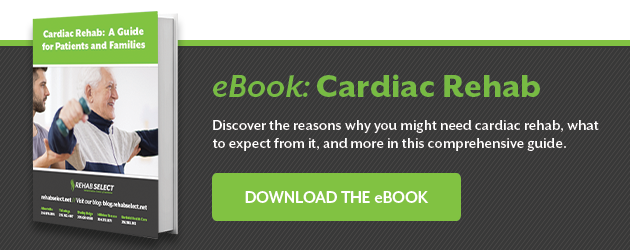
If you’ve recently suffered a heart attack, or are experiencing chronic or acute heart disease, you may be referred for cardiac rehabilitation. The American Heart Association defines cardiac rehab as “a medically supervised program designed to improve your cardiovascular health if you have experienced heart attack, heart failure, angioplasty or heart surgery.” The best cardiac rehab centers design customized programs that include exercise and education to help patients recover successfully, reduce and manage symptoms, and improve their quality of life.
Achieving Your Cardiac Rehab Goals
Depending on your heart condition, you may begin cardiac rehab while you’re still in the hospital or you may start it as an outpatient. Before starting a cardiac rehab program, you will be carefully assessed to determine the current state of your heart and overall health, as well as any other conditions that might affect your recovery. Your healthcare provider will combine this information with your personal goals and current level of physical fitness to form a clear picture of how to structure your cardiac rehab goals. Your doctor and treatment team will then put together an individualized rehabilitation program to help you start your journey toward a full recovery and better health.
Though every patient’s recovery is different, the first phases of cardiac rehab usually last around three months. You will work with a team of rehab professionals, including cardiologists, a specialized nursing staff, physical therapists, nutritionists, and mental health specialists. Cardiac rehabilitation comprises three key components:
1. Exercise
Exercise is one of the most important ways you can meet the goals of cardiac rehabilitation. The key is to improve your physical well-being as safely as possible. You will be guided through a series of exercises, progressing in difficulty over time as your fitness improves. The aim is to show you how to build exercise into your daily routine, without putting too much pressure on your heart.
Your exercise program will likely include both aerobic exercise and resistance training. According to the American College of Cardiology, depending on your starting fitness level, you may begin simply with sitting up and getting out of bed, progressing carefully to walking, climbing stairs, or cycling on a stationary bike.
Resistance training might include activities such as lifting yourself up out of a chair, which can progress to using hand weights or resistance bands to improve your overall strength and muscle tone. Over time, you will be encouraged to monitor your own heart rate while you exercise and develop your confidence in exercising on your own.
2. Education
Patient education is critical to achieving your cardiac rehab goals. During a rehabilitation program, you’ll learn:
- How to manage your diet to improve your heart health
- How to make the necessary lifestyle changes for a healthy lifestyle, such as quitting smoking
- More about your heart condition, including how it affects your health and how to manage your symptoms
- How to manage your medications
One purpose of cardiac rehab is to equip you with the knowledge you need to feel confident in taking care of yourself once you’ve finished rehab and returned home. You should leave with a clear understanding of how to live a heart-healthy lifestyle, and what you need to do to gain a better quality of life.
3. Stress Management
The goals of cardiac rehabilitation include helping you manage stress better. Cardiac events can be highly traumatic —especially if you’ve been hospitalized for an acute occurrence like a heart attack.
In addition, stress and anxiety are known to contribute to many heart conditions, and unchecked anxiety could make your symptoms worse. As a result, you may benefit from working with a therapist or mental health professional during the course of your rehabilitation.
You may learn breathing techniques, meditation, or new ways of thinking that can help you feel less anxious or stressed in the future. You may also receive guidance on lifestyle changes that can help you create a less stressful, healthier future for yourself.
The Purpose of Cardiac Rehab
Cardiac rehab can be challenging - after all, when you’re not feeling well, it can be hard to take on challenges and learn new skills. However, it can have a significant impact on your overall well-being in the future. In fact, the American Heart Association reports that “cardiac rehab is how you can lower your risk of a second cardiac event.”
Achieving the goals of cardiac rehabilitation program can lead to these health benefits:
1. Improve heart strength
Cardiac rehab has been proven to “lower the likelihood of future heart problems or related death,” states the American College of Cardiologists. The increased fitness you’ll gain can develop your heart strength, while the reduction in body fat will mean you’re putting less pressure on your heart.
2. Increase fitness
Completing your cardiac rehab goals can have a major impact on your overall fitness. You should find that you are able to conduct your daily activities, such as walking, doing chores or climbing stairs, with less difficulty. You may lose weight or more easily maintain a healthy weight. You might find that as your aerobic fitness increases, you feel more energetic and positive than you did before.
3. Boost your mood
There’s no question that living with a heart condition is tough - cardiac rehab can help you reduce anxiety, feel better, and enjoy a higher quality of life than you were living before.
Meeting fellow heart patients can also be a very positive experience - for many people, finding a community of others who understand exactly what you’re going through can be a very healing part of the cardiac rehab process. In the words of the Mayo Clinic, “Cardiac rehabilitation can guide you through fear and anxiety as you return to an active lifestyle with more motivation and energy to do the things you enjoy.”
4. Build a foundation for the future
The purpose of cardiac rehab extends beyond initial recovery. The training and exercise habits you learn can help you make the healthy choices and changes you need to live a longer, happier life. According to the CDC, about 800,000 people in the United States have a heart attack every year and one in four of those people already had a heart attack. The bottom line? Cardiac rehabilitation not only can help a person recover from a heart problem but can also prevent future heart problems.
Find Cardiac Rehab in Alabama
You can benefit from cardiac rehabilitation if you’ve experienced any of the following events:
- heart attack (myocardial infarction)
- heart condition, such as coronary artery disease (CAD), angina or heart failure
- heart procedure or surgery, including coronary artery bypass graft (CABG) surgery, percutaneous coronary intervention (PCI, including coronary or balloon angioplasty and stenting), valve replacement, a pacemaker or implantable cardioverter defibrillator (ICD)
Rehab Select is a trusted provider of cardiac rehabilitation with five locations in Alabama. We offer a personalized, physician-led program to improve your heart health and quality of life throughout all phases of rehab – from post-acute care to post-rehab maintenance. Our team of expert therapists create customized programs for patients that include a progressive schedule of supervised physical and occupational therapy to help you achieve your cardiac rehab goals. You can also expect to learn strategies to maintain a healthy lifestyle and reduce stress and anxiety. To find out more about our Alabama-based cardiac rehab, contact us today.





